|
|
|||
|
(Back to Preceding Week; on to Next Week) |
|
NOTE 1: We spent three weeks banding hummingbirds in Costa Rica in early 2008. The following account is for Week Three. Week One is summarized under Alpha Group, Week Two at Omega Group. To get the "big picture," we encourage you to examine those two accounts before reading further on this page. NOTE 2: Three more nine-day hummingbird expeditions are scheduled for 2009: 24 January-1 Feb, 3-11 Feb, and 13-21 Feb. For more information see 2009 Hummingbird Expeditions and contact EDUCATION. COSTA RICA HUMMINGBIRDS 2008: After filling our bird feeders and battening down the (nut)hatches at Hilton Pond Center, we began our 2008 Operation RubyThroat hummingbird expeditions to Costa Rica on the morning of 21 January, flying nonstop from Charlotte NC to the international airport in San Jose. As we cleared immigration and customs we were greeted by Ernesto Carman Jr. (our in-country bilingual colleague and expert natural history guide) and Elaida Villanueva Mayorga (Ernesto's girlfriend, herself a naturalist who participated in our first excursion to Costa Rica in December 2004). It was a long, slow ride on the Pan American Highway but eventually we got to Liberia and drove halfway up Rincon de la Vieja to Buena Vista Lodge, our usual headquarters for hummingbird studies in the tropics. There we were met by a temporary bus driver who, the next morning (3 February), took the advance team back down the mountain to the small town of Cañas Dulces to scout potential locations in which Ruby-throated Hummingbirds, Archilochus colubris, might be captured for banding. We especially looked at fields of Aloe Vera that had harbored ruby-throats in past winters and were elated to see quite a few of these tiny birds feeding on a profusion of aloe blossoms. Hobbled but undeterred, Fearless Leader (plus Ernesto and "permanent" bus driver Whiskers) bid farewell to Alpha Group, took a "day off," and then greeted a new team--"Krazy '08s Omega"--as they flew into Liberia. By the end of THEIR eight days, the Omega group had 77 banded ruby-throats to their credit--eclipsing the still-fresh record set by their immediate predecessors. The 135 RTHU banded by Alpha and Omega during 16 days in 2008 was greater than the 97 captured by our first four groups from 2004 through 2007 and brought to 232 the grand total for Ruby-throated Hummingbirds banded in Guanacaste Province by Operation RubyThroat.
All text & photos © Hilton Pond Center Actually, those final numbers aren't exactly right. After seeing off the Alpha team at the airport on 1 February, the leadership team went back to Cañas Dulces to observe a famous Jocote tree used by the first two groups back in 2004-2005. We had hung a feeder in this tree before this year's Alpha group arrived,
First, we should point out the leadership team spent more than seven hours over three days hours at the Jocote tree. We trapped only four birds but got to observe plenty of inter- and intra-specific interactions--such as when Ruby-throated Hummingbirds or various ages and sexes drove each other away from the feeder/trap. Second, and we think of greater interest, was an observation that came about because--on a whim--we decided to color mark hummers at the Jocote tree with a different pattern than those in the aloe fields; i.e., the aloe birds got only one stripe as noted above, while the Jocote birds got TWO stripes of blue (immature male, below left). This scheme paid off very nicely on 2 February as keen-eyed Ernesto (above) watched the Jocote tree through binoculars and spied a ruby-throat with just ONE stripe. Third, when the Omega group departed on 10 February, driver Whiskers departed via bus for his home near San Jose, and the leadership team drove back into Liberia in Ernesto's car--by now laden with field equipment and net poles. In Liberia we had lunch, picked up medical supplies for Fearless Leader's bum ankle, and went to meet Ernie Carman (Ernesto's dad) and Elaida (Ernesto's girlfriend), who had ridden the bus from Paraiso to join us. This new quartet--known informally as "Krazy '08s Delta"--then headed back to the aloe fields to see what we could see.
All text & photos © Hilton Pond Center DAY ONE DELTA (10 Feb): Although we had studied low-resolution GoogleEarth images of the aloe fields at Cañas Dulces, it was difficult to know just how extensive the plantation might be--especially because some farm roads were inaccessible for the bus we used for our regular groups. With Ernesto's four-wheel drive car, however, we could explore further--which is exactly what the Delta group did on our first afternoon together. Although the first four Aloe Vera fields (AV1-AV4) were on fairly level ground, our exploration took us to areas of the plantation that were quite hilly (above). Some of this acreage was crisscrossed by washed-out roads inaccessible even for Ernesto's car. After driving where we could, we discovered there actually were NINE distinct aloe fields, some with denser flowers than AV3 and AV4 where our Alpha and Omega groups had banded their impressive total of 135 birds in 12 combined days of work.
When we had finished driving around the aloe fields, we four Delta group members looked at the clock, realized it was just 3:20 p.m. with at least two good hours of daylight remaining, and simultaneously arrived at the same plan: "We should try to catch some hummingbirds!" And so we did, quickly deploying four mist nets along the edge of the previously uncharted and unused AV7. To be more accurate, we finished opening the first net at 3:35 p.m. and within three minutes already had caught the first Ruby-throated Hummingbird. Within four minutes our first net at AV7 caught another ruby-throat . . . and then the flood gates opened. Amazingly, we can report that from 3:35 to 5:47 p.m.--a mere two hours and 12 minutes--the Delta group netted and banded 21 new Ruby-throated Hummingbirds! DAY TWO DELTA (11 Feb): Although the aloe fields near Cañas Dulces have been laden with Ruby-throated Hummingbirds, we've always been curious about whether there might be other ruby-throat havens within northern Guanacaste. That explains why on the morning of 11 Feb the Delta group ate breakfast at Buena Vista Lodge and then piled into Ernesto's car for a drive north toward the Nicaragua-Costa Rica border. As shown on the map below, to explore this area we needed to navigate back down the slopes of Rincon de la Vieja through Cañas Dulces and then turn north on the Pan American Highway (CR1).
Click on map above to open a larger version in a new browser window; On the way north we explored several dirt roads that went east from CR1 into ranchland and/or Guanacaste National Park, but none seemed very promising. Eventually we drove east on CR4 (toward Santa Cecila), past extensive orange groves and across several small streams. Although this part of Guanacaste is less than 30 miles north of Cañas Dulces, the climate is different-- more humid, as indicated by a greater abundance of epiphytic orchids and bromeliads on trees. We even ran into a heavy rainstorm, our first precipitation in more than two weeks in Costa Rica. We saw a few ruby-throats, but not many.
We DID stop to photograph blossoms from a Pochote tree, Bombacopsis quinata, and were reminded that hummingbirds are not the only organisms that take nectar from flowers. A large unidentified red ant was at the base of one Pochote bloom (above), filling its abdomen with sweet juice. We doubt ants are very good Pochote pollinators because they don't seem to come in contact with pollen-bearing anthers when they only visit the flower's base. Just south of the Nicaraguan border we found another less-traveled dirt road that went east and eventually forded the Sapoa River, a tributary that flows into Lake Nicaragua. Although we thought surely ruby-throats would be plentiful in this area, they were not--but that may have been because it was the wromg time of year and/or because there were relatively few hummingbird flowers. (NOTE: In next week's installment of "This Week at Hilton Pond" we'll explain in detail why we went north toward Nicaragua in our pursuit of Ruby-throated Hummingbirds.) After spending the morning on the road in the hope of finding a new "mother lode" of ruby-throats, the Delta group got pretty hungry, so we eagerly pulled into the town of La Cruz (main thoroughfare, below left), just east of CR1. From La Cruz we headed back south to Cañas Dulces for--you guessed it--another shot at mist netting hummingbirds in AV7, the aloe field that had been so full of hummers the day before. We arrived at about 3:20 p.m. and started setting up the same net lanes. When the first ruby-throat hit a net at 15 minutes later we just knew we were going to have another great day of banding, but that conclusion was both premature and incorrect. We captured only seven RTHU by 5:20 p.m.--what a difference a day makes--after which we closed the nets and drove back up the hill for our last night at Buena Vista, satisfied we had now banded a total of 167 Ruby-throated Hummingbirds in Guanacaste in 2008.
All text & photos © Hilton Pond Center Incidentally, on this day we also netted a bird we had never handled: A Yellow-olive Flycatcher, Tolmomyias sulphurescens (above). This Costa Rican resident looked a lot more like a vireo than a flycatcher, but its gray eye confirmed its identification.
DAY THREE DELTA (12 Feb): On the morning of 12 February we ate one more breakfast at Buena Vista Lodge, checked out of rooms that had been home for two and a half weeks, loaded luggage and field gear into Ernesto's already crowded car, and turned in a pair of crutches that had been holding up Fearless Leader since the horseback riding accident. We also bid farewell to a seven-foot-long American Crocodile, Crocodylus acutus (above), that lived in a pond right outside our cabin. We're grateful this fat-tailed reptile seemed more interested in sunning itself than in chasing a slow-moving human with a bad ankle.
All text & photos © Hilton Pond Center On the way down the mountain from Buena Vista Lodge we stopped at "The Wall," a limestone cliff carved out by a rushing stream. Our main reason for tarrying was so Ernesto could take a second look at--and get another photo of (above)--an unusual nest under an overhang on the cliff face. He first saw this structure back during Week One and wanted to know if was active (it appeared to be) or if he could spot its maker (he couldn't). Ernesto suspected the nest might be the work of the Lesser Swallow-tailed Swift, Panyptila cayennensis, a black-and-white Central American relative of the Chimney Swift that breeds across North America. What was so exciting about this observation is that the rather uncommon Lesser Swallow-tailed Swift is not known to nest in central Guanacaste Province, preferring instead to breed along the Caribbean and south Pacific coasts of Costa Rica and in the central volcanic ridge. With photos taken two weeks apart, we can talk later with a swift specialist for an expert opinion. (While stopped at The Wall there was a nice "bonus": Along the stream we got to see and hear an elusive pair of Sunbitterns calling back and forth.)
As we progressed down the mountain we made several additional stops to take photos of subjects we had missed during the first two weeks. One of those was a particularly robust pair of Coral Trees, Erythrina sp. (above)--leafless, but laden with long, tubular red blossoms. The flowers--about four inches long--are sometimes used by Ruby-throated Hummingbirds, but the elongated bill of the Plain-capped Starthroat, Heliomaster constantii (below), is much better adapted for lapping nectar from this plant. In fact, it appeared a pair of Starthroats had staked out these particular Coral Trees and made regular visits when we stopped to observe.
All text & photos © Hilton Pond Center Rolling through the town of Cañas Dulces and past the aloe fields we turned south on the Pan American Highway and then west at Liberia onto CR21. This road goes past the international airport and toward many Guanacaste beaches that have begin to attract large numbers of tourists--especially surfers and anglers--from around the world. High-rise hotels and business parks have sprung up along the Pacific Coast in recent years and each seems determined to have more advertising billboards than its competitors. After spending almost three weeks among the idyllic splendor of aloe fields and the volcanic majesty of Rincon de la Vieja, it was culture shock to see all these roadside eyesores marring the landscape--far worse than anything we've seen along interstate highways in the U.S. Incidentally, the popularity of Pacific beaches has also attracted a glut of speculators and land developers, so more and more farms and ranches in Guanacaste are being bought out by foreigners--especially Americans and Europeans seemingly intent on turning Guanacaste into a giant subdivision.
Along the way we stopped in the small city of Nicoya. At town center was a shady park and, as is common in Costa Rica, a church--in this case an old stone cathedral originally built in 1644, destroyed by earthquakes in 1822, and rebuilt in 1831. This imposing structure was filled with relics and statuary, some dating to the original building. It was interesting to know this living, still-used edifice--constructed by Spanish priests, settlers, and perhaps indigenous peoples--is at least as old as some of the first buildings built by British immigrants in what is now the eastern United States. Our actual destination this day wasn't the cathedral at Nicoya but the home of Cis Wilton, a former New York television producer who purchased an old 100-plus-acre farm in Cerro Azul--a sparsely settled and lush mountain region on the western edge of the Nicoya Peninsula (right). We hung another feeder on Cis's clothesline and then Ernesto and Elaida volunteered to deploy a couple of mist nets behind the cottage. Within 10 minutes we netted three Ruby-throated Hummingbirds and had to shut down the operation shortly thereafter before twilight got the best of us. Cis invited us to come back to band next time we were in Costa Rica--something we undoubtedly will do--and bid us farewell as we drove partway down the mountain to a bed and breakfast where we spent the night. NOTE: When we added the three birds at Cis's house to the 58 netted by the Alpha group, 77 by the Omega group, and 32 already caught by the Delta group, our 2008 overall total stood at 170 Ruby-throated Hummingbirds banded in Costa Rica in 2008, and that makes 267 the grand total for all six Operation RubyThroat expeditions to Guanacaste. That's a lot of birds! DAY FOUR DELTA (13 Feb): On 13 February we rose early, had breakfast, and finished our ride down the mountain at Cerro Azul before turning east in the direction of Hacienda Solimar--the next potential hummingbird spot we wanted to investigate. Earlier in the year Ernesto had seen Ruby-throated Hummingbirds feeding on a hedge of Blue Porterweed (False Vervain) at the hacienda's main lodge, so we were trying to learn if this might be an auxiliary banding site on future Costa Rica hummingbird expeditions. It took a couple of hours on good roads to get to Solimar, a huge 8,000-acre cattle ranch near the eastern edge of the Nicoya Peninsula. Despite the scenery, it was a wasted trip because the groundskeepers had whacked down most of the vervain a few days before our arrival. Nary a hummingbird did we see.
Departing Solimar we began the last leg of our road trip, crossing the Tempisque River via Puente de la Amistad de Costa Rica-Taiwan (AKA The "Costa Rica-Taiwan Friendship Bridge," above)--built by the Taiwanese government to honor Costa Rica. This half-mile-long structure, completed in 2003, is now the main route to San Jose and replaces several ferries that were much slower than a highway link. Upon crossing the bridge we were homeward bound, stopping only for lunch before arriving at Finca Cristina by late afternoon. Thanks to the hospitality of Linda and Ernie Carman--owners of this truly inspirational organic shade-grown coffee farm--we had a place to shower, sleep, and eat on our last night in Costa Rica. Next morning (14 February) we re-packed our bags, re-loaded them into Ernesto's vehicle, and re-traced the route back to the airport at San Jose. There, after heartfelt hugs for Ernesto and Elaida, Fearless Leader got considerable help from airline employees as he hobbled through customs and immigration on his still-creaky ankle, boarded his plane, and touched down late evening at Charlotte NC--where he was met by wife Susan just in time to celebrate Valentines Day and their 37th wedding anniversary!
All text & photos © Hilton Pond Center KRAZY '08s DELTA GROUP RESULTS In 2008, two groups of teachers and citizen scientists from the U.S. and Canada spent eight days each in Guanacaste, Costa Rica, on behalf of Operation RubyThroat: The Hummingbird Project. During each expedition, participants deployed mist nets on six mornings in Aloe Vera fields near Cañas Dulces and helped capture, measure, band, release, and observe Ruby-throated Hummingbirds. Results of their work are detailed in words and photos at Week One 2008 and Week Two 2008.
All text, photos & tables © Hilton Pond Center As the second group departed, a third team (Delta Group)--consisting of trip leader and hummingbird bander Bill Hilton Jr., expert in-country guide Ernesto Carman Jr., naturalist Elaida Villanueva Mayorga, and organic coffee farmer extraordinaire Ernie Carman--remained in Guanacaste to scout potential study sites and conduct two additional days of banding at the aloe plantation. Delta Group banding results are given in Table 1 (above); these include three days of trapping and banding by Hilton and Carman at the Jocote tree in Cañas Dulces. In Aloe Field #7--which was used for the first time in 2008--the Delta group netted and banded an abundance of young males but few females. (NOTE: All trapping and netting by the Delta group was during afternoon hours in AV7, while 2008 Week One and Week Two participants typically ran nets in AV3 and AV4 in the morning from 7-11 a.m. Thus, capture results heavily skewed toward young males in AV7 could be due to time of day, new location, or some other factor. Additional work in future years at AV7 may provide a better understanding of this situation.)
All text, photos & tables © Hilton Pond Center
Table 2 (above) outlines our cumulative banding results for six Operation RubyThroat expeditions to Guanacaste from 2004 through 2008. According to Bird Banding Laboratory records, prior to our work in Guanacaste only 14 Ruby-throated Hummingbirds had been banded in Costa Rica with U.S. bands, the latest in 1988; from 1962 through 1995, 32 others were banded in Mexico (29), Belize (2), and Honduras (1). These birds apparently were incidental captures, so to our knowledge Operation RubyThroat is the first systematic long-term banding and observational study of RTHU on their wintering grounds in the Neotropics.
During our first expedition to Guanacaste (Year 1), all birds we caught during Week One were banded in December 2004, so two young males with incomplete red gorgets and/or heavy throat streaking (below right) must have hatched out in the summer of that year; thus, they were aged as HY or Hatch Year birds. Four females caught that December were aged U for Unknown because they might have hatched either in 2004 or in an earlier year. According to Bird Banding Laboratory protocol, all these birds became "one year older" on 1 January. Based on Table 2, if we lump together our banded ruby-throats by sex rather than age AND sex we find that in 2008 we caught considerably more males (108, or 63.5%) than females (62, or 36.5%)--roughly a 3:2 ratio. The combined results of all six expeditions resulted in 144 males (53.9%) and 123 females (46.1%)--closer to a 1:1 ratio. We do not know if these ratios are representative of Ruby-throated Hummingbirds on their wintering grounds elsewhere, from Mexico to northern Panama. We DO know that during 25 years of banding at Hilton Pond Center our 3,614 RTHU captures have included 1,955 males (54 %) and 1,659 females (46%)--not too far from a 1:1 ratio. (NOTE: Hilton Pond numbers include spring and fall migrants plus summer resident breeding birds and their offspring, banded late March through mid-October.) It is difficult to compare results year-to-year because in our attempt to find the optimal time and location for banding winter ruby-throats we introduced several variables. For example, during the six expeditions we came to Guanacaste at different times (late December and early January, late January and early February, and late February); we worked at several sub-sites (different Aloe Vera fields, plus the Jocote tree); and conducted field work for six days during each week in 2008 (two more than in previous years). Based on our four years of work, we now believe running mist nets in late January and early February is the optimal time to catch RTHU in Costa Rica. Going to Guanacaste too early in the winter is not advisable because Aloe Vera is not yet at peak bloom, and banding efforts in late February apparently give an incomplete picture because adult male ruby-throats have already started heading north in spring migration. (That said, it would be interesting to visit Guanacaste in October and November--before the rainy season has ended and before aloe is flowering--to see what the ruby-throats are doing.)
Regardless of variables, our 270 Ruby-throated Hummingbirds banded in Costa Rica during six expeditions is a substantial accomplishment that provides valuable information about status and behavior of the species within at least part of its tropical wintering grounds. For one, we have gained a much better understanding of molt progression in RTHU, a phenomenon not seen in North America except on those few ruby-throats that overwinter. Among other things, our birds-in-the-hand confirm RTHU molt their primary feathers from innermost (#1) to outermost (#10)--except they skip #9 and bring it in last. We also got to observe tail molt in ruby-throats; in the bird at left the two outermost rectrices (tail feathers) are just coming in. We can tell this photo is of an "adult" male because the central rectrices are short, giving the tail a forked appearance. In addition, adult male rectrices are pointed and they all lack white tips. By comparison, female and juvenile male Ruby-throated Hummingbirds have rounded tails with rounded tail feathers (below right), and the outer three rectrices have prominent white tips.
The big unknowns for ruby-throats is where wintering birds in Costa Rica came from and/or specifically where those birds will go when they return to North America to breed. These questions will be answered only when one of our Guanacaste birds is recaptured "up north," or when we encounter a banded bird from North America in the aloe fields. For us, this would be the "holy grail" of Ruby-throated Hummingbird banding--a goal we anticipate will keep us going back to Costa Rica each winter for years to come.
All text & photos © Hilton Pond Center White-throated female Ruby-throated Hummingbird taking nectar from an Aloe Vera blossom (above)
All text & photos © Hilton Pond Center Ruby-throated Hummingbird feeding on white flowers of an Inga tree (above). The irregular shape of the hummer's wing is the result of primary feathers lost during the molt process. OPERATION RUBYTHROAT'S During our six Operation RubyThroat expeditions to Guanacaste Province in Costa Rica, we have focused primarily on banding, ageing, sexing, and measuring Ruby-throated Hummingbirds and checking their molt progression. However, long hours in the field also have provided opportunities to make observations of ruby-throats feeding not only on Aloe Vera blossoms (above) but also on flowers of native forbs, vines, shrubs, and trees. With all due respect to David Lettermen's "Top Ten" list, herein we list the "Top Ten" (plus one) Hummingbird Plants frequented by Ruby-throated Hummingbirds on our Guanacaste banding site. The order is our preference--not necessarily that of the hummingbirds--but we do save some of the most commonly visited flowers for last.
All text & photos © Hilton Pond Center NUMBER 11: We nicknamed this herbaceous plant "Stinky Pinky" because of the rather noxious odor of its hairy, deep green foliage. The dark pink blossom--visited occasionally by Ruby-throated Hummingbirds--is about three-fourths of an inch long. The actual name is Wild Petunia, Ruellia inundata, a member of the Acanthaceae (Acanthus Family). (Thanks to Chip Tynan for checking with Dr. Michael Grayum of Missouri Botanical Garden, who identified this plant for us.)
All text & photos © Hilton Pond Center NUMBER 10: This herbaceous plant--with its red, tubular one-inch flowers--grew in shady locations on the perimeter of the aloe fields in Guanacaste. In some spots it was the dominant plant in the forbs layer. The blossoms were visited by several kinds of hummingbirds, including ruby-throats and Stripe-throated Hermits (the only one of nine hummer species on our study site we have never captured). We believe this plant, a member of the Acanthaceae (Acanthus Family), is Aphelandra scabra--which has no common name of which we are aware. (Thanks to Chip Tynan for checking with Dr. Michael Grayum of Missouri Botanical Garden, who identified this plant for us.)
All text & photos © Hilton Pond Center NUMBER 9: The Papaya, Carica papaya, has two types of white flowers. The female flower is more spherical, while male inflorescence is thin, tubular, about an inch long, and borne in clusters (above). We observed Ruby-throated Hummingbirds feeding in trees with male flowers; female flowers are not known to produce nectar and apparently attract only moths as pollinators. The female blossoms do produce sizeable fruits, however, for which the Papaya is world-famous.
All text & photos © Hilton Pond Center NUMBER 8: The Flame Vine, Combretum fruticosum, bears brilliant orange flowers in a six-inch-long cluster the general shape of a toothbrush. This evergreen vine is in the Combretaceae. Its blossoms yield nectar attractive to many kinds of birds--not just hummers--and it's not uncommon to see Baltimore Orioles and Tennessee Warblers with head feathers discolored orange by Combretum pollen. As the flowers mature they may change color, hence the plant's alternate name of "Chameleon Vine."
All text & photos © Hilton Pond Center NUMBER 7: The Pochote, Bombacopsis quinata, is a Costa Rican canopy tree whose flowers are difficult to photograph. For one, they appear only in morning, and for another they're usually high on unreachable tree branches. (Ruby-throated Hummingbirds, of course, have no trouble feeding on nectar at those heights.) This member of the Bombacaceae--a traditional plant family that may be re-classified--is most recognizable from sharp cone-shaped spines covering its trunk.
All text & photos © Hilton Pond Center NUMBER 6: Three-inch-wide flowers of Inga trees, Inga edulis, superficially resemble those of the Pochote just above it on this list, but actually are quite different. In fact, Inga is in an entirely different family--the Mimosaceae--which is why its flowers may remind you of the pink ones on Mimosa trees cultivated by folks in the southeastern U.S. to attract hummingbirds. This year we discovered Inga trees in the woods adjacent to our aloe field study site and were impressed with the diversity of hummingbirds and Neotropical migrants--including orioles--that fed on Inga nectar in the canopy.
All text & photos © Hilton Pond Center NUMBER 5: Shrub Verbena (AKA Lantana), Lantana camara, should be familiar to many U.S. gardeners who grow it as a hummingbird plant. A member of the Verbenaceae, in some southern states and California it has escaped and is naturalized. In a given cluster, individual flowers--which are tube-shaped--tend to change color as they age, resulting in umbels of two or three different hues. The leaves are aromatic and the blossoms also attract many butterflies and several hummingbird species on our Guanacste study site.
All text & photos © Hilton Pond Center NUMBER 4: Blue Porterweed (AKA False Vervain), Stachytarpheta frantzii, grows wild throughout Guanacaste and is sometimes cultivated as a hedge plant. We found it as a near-monoculture in pastures that had not hosted cattle for a few years; it sometimes grows alongside Lantana (see Number 5 above), its relative in the Verbenaceae. Any patch of porterweed along the mountain road from Buena Vista Lodge to our study site was almost guaranteed to have at least one Ruby-throated Hummingbird.
All text & photos © Hilton Pond Center NUMBER 3: Turk's Cap, Malvaviscus arboreus, grows throughout Guanacaste Province from the coastal plain to volcanic slopes. The bright red color of its two-inch flower makes it easy for Ruby-throated Hummingbirds to find against green vegetation, and the blossom's abundant nectar keeps them coming back for more. A member of the Mallow Family (Malvaceae), this plant is a close relative of hibiscus and is sometimes cultivated in the southern and southwestern U.S.
All text & photos © Hilton Pond Center NUMBER 2: The blossoms of this very Jocote tree, Spondias purpurea, turned out to be a life-saver in December 2004. That year, our first expeditions to Guanacaste Province arrived "too early," i.e., before fields of Aloe Vera were in bloom. Fortunately, nectar within the tiny eighth-inch flowers of the Jocote attracted Ruby-throated Hummingbirds we were then able to trap and band. Jocotes are in the Anacardiaceae--the same family as Poison Ivy, Mango, and Cashew--and produce a green drupe that locals eat with salt before it ripens to red.
All text & photos © Hilton Pond Center NUMBER 1: Aloe vera, AKA Aloe barbadensis, is a stemless, rosette plant with succulentous sword-shaped leaves edged with small spines. A member of the Lily Family (Liliaceae), it originated in North Africa but is cultivated commercially in dry areas of Central America--as well as in California, Florida, and Texas. The tall yellow stalk bears many 1.5-inch flowers that mature sequentially (bottom to top) and provide an on-going nectar supply over several weeks. Even though this plant is non-native, many wintering Ruby-throated Hummingbirds are drawn to aloe grown commercially in Guanacaste Province. These aloe fields, near Liberia, are the primary tropical study site for Operation RubyThroat: The Hummingbird Project.
All text & photos © Hilton Pond Center Second year male Ruby-throated Hummingbird with incomplete red gorget investigating Aloe Vera blossoms (above) NOTE 1: We spent three weeks banding hummingbirds in Costa Rica in early 2008. The account above is for Week Three. Week One is summarized under Alpha Group, week two under Omega Group. NOTE 2: Three more nine-day hummingbird expeditions are scheduled for 2009: 24 January-1 Feb, 3-11 Feb, and 13-21 Feb. For more information see 2009 Hummingbird Expeditions and contact EDUCATION.
Comments or questions about this week's installment?
Thanks to the following fine folks for recent gifts in support of Hilton Pond Center for Piedmont Natural History and/or Operation RubyThroat: The Hummingbird Project. Your tax-deductible contributions allow us to continue writing, photographing, and sharing "This Week at Hilton Pond." (Please see Support if you'd like to make a gift of your own.)
IMPORTANT NOTE: If you ever shop on-line, you may be interested in becoming a member of iGive, through which nearly 700 on-line stores from Barnes & Noble to Lands' End will donate a percentage of your purchase price in support of Hilton Pond Center and Operation RubyThroat. For every new member who signs up and makes an on-line purchase iGive will donate an ADDITIONAL $5 to the Center. Please sign up by going to the iGive Web site; as of this week, 117 members have signed up to help Hilton Pond Center. It's a painless, important way for YOU to support our work in conservation, education, and research. "This Week at Hilton Pond" is written & photographed You may wish to consult our Index of all nature topics covered since February 2000. You can also use our on-line Hilton Pond Search Engine at the bottom of this page. For a free, non-fattening, on-line subscription to |
||||||||||||||||||||||||||||||||||||||||||||||||||||||||||||||||||||||||||||||||||||||
|
Make direct donations on-line through
Network for Good: |
|
|
LIKE TO SHOP ON-LINE?
Donate a portion of your purchase price from 700+ top on-line stores via iGive: |
|
|
Use your PayPal account
to make direct donations: |
|
| The highly coveted Operation RubyThroat T-shirt --four-color silk-screened--is made of top-quality 100% white cotton--highlights the Operation RubyThroat logo on the front and the project's Web address (www.rubythroat.org) across the back.
Now you can wear this unique shirt AND help support Operation RubyThroat: The Hummingbird Project and Hilton Pond Center. Be sure to let us know your mailing address and adult shirt size: Small (suitable for children), Medium, Large, X-Large, or XX-Large. These shirts don't shrink! Price ($21.50) includes U.S. shipping. A major gift of $1,000 gets you two Special Edition T-shirts with "Major Donor" on the sleeve. |
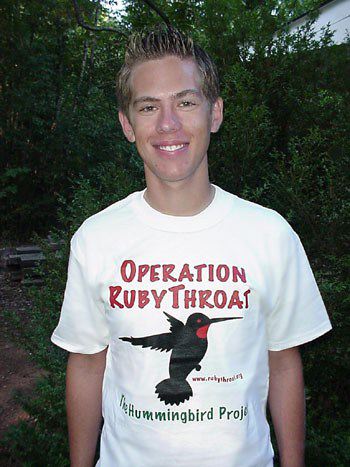
Need a Special Gift just in time for the Holidays? (Or maybe you'd like to make a tax-deductible donation during 2007) If so, why not use our new handy-dandy on-line Google Checkout below to place your secure credit card order or become a Major Donor today? |
|
|
|
|
SPECIES BANDED THIS WEEK: NONE THIS WEEK; IN COSTA RICA (see write-up above) * = New species for 2008 WEEKLY BANDING TOTAL 0 species 0 individuals YEARLY BANDING TOTAL (2008) 8 species 88 individuals 27-YEAR BANDING GRAND TOTAL (since 28 June 1982) 124 species 50,255 individuals NOTABLE RECAPTURES THIS WEEK (with original banding date, sex, and current age) NONE THIS WEEK; IN COSTA RICA (see write-up above)
|
OTHER NATURE NOTES OF INTEREST
|
|
|
|
(Back to Preceding Week; on to Next Week) Up to Top of Page Back to This Week at Hilton Pond Center Current Weather Conditions at Hilton Pond Center |
 You can also post questions for The Piedmont Naturalist |
Join the |
Search Engine for |
|
|
Baby Toy Shopping

 Ernesto took us on to Paraíso and an overnight stay at his family's Finca Cristina--one of the world's first fully organic shade-grown coffee farms. (At left, a Coral Bean tree at Finca Cristina casts shade on Coffee plants in the shrub layer. Note the ferns and bromeliads on the tree trunk.) Next morning Ernesto loaded luggage, banding equipment, and other field gear into his "new" car, upon which the advance team (i.e., Ernesto and trip leader/hummingbird bander Bill Hilton Jr.) set out for Guanacaste Province on the Pacific coast of Costa Rica.
Ernesto took us on to Paraíso and an overnight stay at his family's Finca Cristina--one of the world's first fully organic shade-grown coffee farms. (At left, a Coral Bean tree at Finca Cristina casts shade on Coffee plants in the shrub layer. Note the ferns and bromeliads on the tree trunk.) Next morning Ernesto loaded luggage, banding equipment, and other field gear into his "new" car, upon which the advance team (i.e., Ernesto and trip leader/hummingbird bander Bill Hilton Jr.) set out for Guanacaste Province on the Pacific coast of Costa Rica.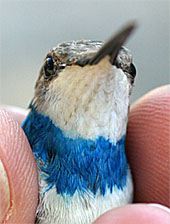 With that good news we headed toward Liberia's international airport to greet 12 enthusiastic adults from the U.S. who had come to study hummingbirds with us. By the end of their eight days in Costa Rica, this group--nicknamed "Krazy '08s Alpha"--had helped capture, band, and color mark 58 Ruby-throated Hummingbirds (color marked female, at right), a number that exceeded 51 RTHU banded by a previous group of "citizen scientists" back in 2006. This was a terrific success by the Alpha group--marred only by a broken ankle suffered by Fearless Leader Hilton during a horseback ride on Alpha Group's last full day in Costa Rica.
With that good news we headed toward Liberia's international airport to greet 12 enthusiastic adults from the U.S. who had come to study hummingbirds with us. By the end of their eight days in Costa Rica, this group--nicknamed "Krazy '08s Alpha"--had helped capture, band, and color mark 58 Ruby-throated Hummingbirds (color marked female, at right), a number that exceeded 51 RTHU banded by a previous group of "citizen scientists" back in 2006. This was a terrific success by the Alpha group--marred only by a broken ankle suffered by Fearless Leader Hilton during a horseback ride on Alpha Group's last full day in Costa Rica.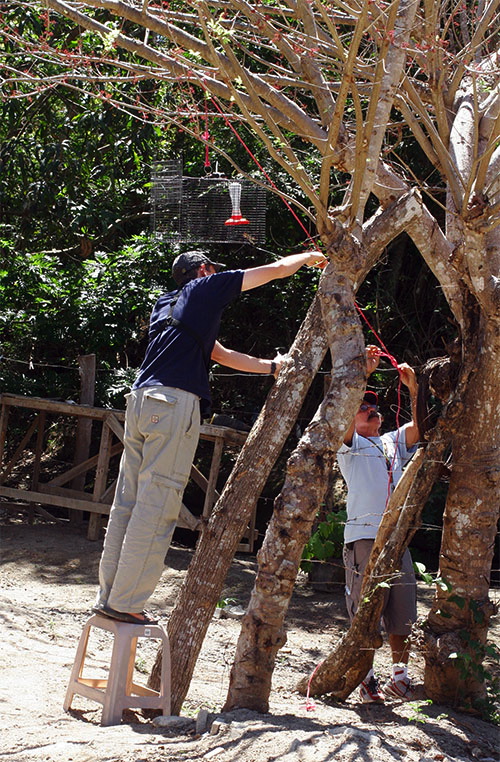
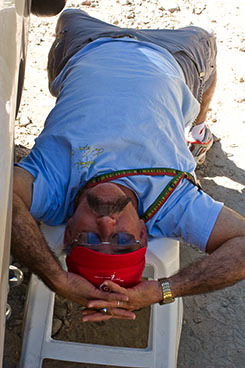 and each day when we passed the Jocote en route to the aloe fields we stopped to see if Ruby-throated Hummingbirds were visiting. They were, so on Alpha group's departure day the leadership team moved the feeder into a portable trap (above) and caught one adult female ruby-throat. Then, on our "day off" between groups (2 February), we celebrated Groundhog Day in Guanacaste by getting bus driver Whiskers to drive us back to the Jocote tree, where we trapped two more RTHU--both adult females. (Whiskers snoozed in the shade, left, for part of the time.) And then, on the morning of 3 February--just before going to the Liberia airport to meet the incoming Omega group--we tried once again with the Jocote tree trap and captured a young male ruby-throat with an incomplete red gorget. Thus, when added to all the ruby-throats captured by Alpha and Omega participants, these four "bonus" birds at the Jocote tree brought the 2008 total to 139 RTHU banded, and the four-year total to 236.
and each day when we passed the Jocote en route to the aloe fields we stopped to see if Ruby-throated Hummingbirds were visiting. They were, so on Alpha group's departure day the leadership team moved the feeder into a portable trap (above) and caught one adult female ruby-throat. Then, on our "day off" between groups (2 February), we celebrated Groundhog Day in Guanacaste by getting bus driver Whiskers to drive us back to the Jocote tree, where we trapped two more RTHU--both adult females. (Whiskers snoozed in the shade, left, for part of the time.) And then, on the morning of 3 February--just before going to the Liberia airport to meet the incoming Omega group--we tried once again with the Jocote tree trap and captured a young male ruby-throat with an incomplete red gorget. Thus, when added to all the ruby-throats captured by Alpha and Omega participants, these four "bonus" birds at the Jocote tree brought the 2008 total to 139 RTHU banded, and the four-year total to 236.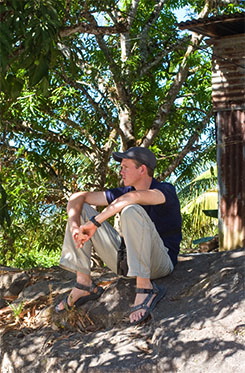 But wait! There's more!
But wait! There's more!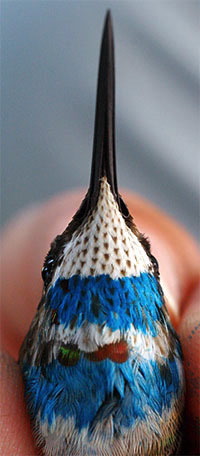 This bird HAD to have been banded in Aloe Vera Field #3 during the preceding week, and now it was in the Jocote tree--more than a HALF MILE due north of the aloe fields. This "distant" sighting brings up interesting questions. Was this singly marked hummer merely wandering around on its wintering grounds? Was the nectar from Jocote blossoms sufficiently tasty to draw this hummer way from the super-abundant aloe flowers down the road? Was this particular RTHU already heading northward on its spring migrational journey? We'll never have the answers to these questions, of course, but it's worth noting that--to our knowledge--this was the first Ruby-throated Hummingbird ever encountered away from its immediate banding locale on wintering grounds in the tropics.
This bird HAD to have been banded in Aloe Vera Field #3 during the preceding week, and now it was in the Jocote tree--more than a HALF MILE due north of the aloe fields. This "distant" sighting brings up interesting questions. Was this singly marked hummer merely wandering around on its wintering grounds? Was the nectar from Jocote blossoms sufficiently tasty to draw this hummer way from the super-abundant aloe flowers down the road? Was this particular RTHU already heading northward on its spring migrational journey? We'll never have the answers to these questions, of course, but it's worth noting that--to our knowledge--this was the first Ruby-throated Hummingbird ever encountered away from its immediate banding locale on wintering grounds in the tropics.
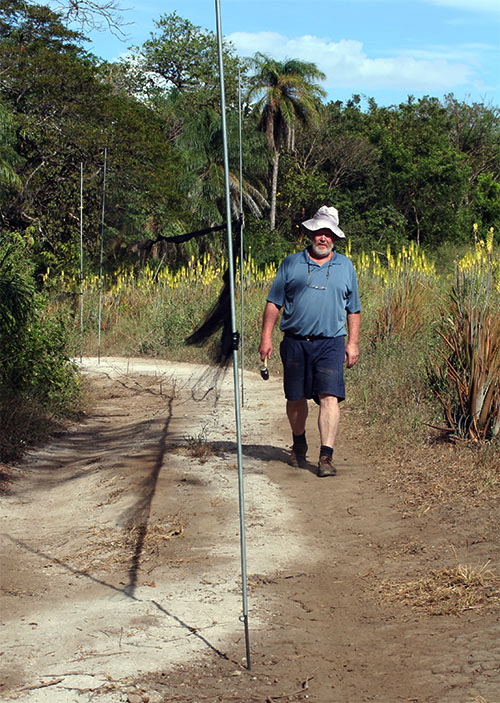
 Trip leader Hilton immediately went to work banding that bird as the rest of the team set up additional nets. (We should note that expert guide Ernesto's father, Ernie Carman--above and at left--was justly proud of several sets of steel rebars he had machined for us prior to Alpha group's arrival back in late January. Thanks to Ernie's work, this year's field workers were able to drive his metal rods into the ground quickly and slide net poles over them, considerably shortening the time it took to deploy mist nets. One further refinement--a loop Ernie welded halfway along each rod--allowed us to pry out stuck rebars.)
Trip leader Hilton immediately went to work banding that bird as the rest of the team set up additional nets. (We should note that expert guide Ernesto's father, Ernie Carman--above and at left--was justly proud of several sets of steel rebars he had machined for us prior to Alpha group's arrival back in late January. Thanks to Ernie's work, this year's field workers were able to drive his metal rods into the ground quickly and slide net poles over them, considerably shortening the time it took to deploy mist nets. One further refinement--a loop Ernie welded halfway along each rod--allowed us to pry out stuck rebars.)  That was a LOT of birds and an amazing amount of work in a short period of time, so we're grateful the energetic and ever-smiling Elaida (right)--an experienced naturalist and careful net-tender--was along to help remove hummers from the nets. The day's birds from AV7 brought our total to 160 RTHU for 2008. All this banding activity left us tuckered out but quite pleased with our afternoon efforts as we drove back up the mountain for another night at Buena Vista Lodge. Because Ernie had never been to Buena Vista we took him to Mirador lookout. The sun had gone down a few hours earlier, but the night was so clear we could see untold millions of stars as we listened to Coyotes howling. Quite a sight and sound--even without a sunset.
That was a LOT of birds and an amazing amount of work in a short period of time, so we're grateful the energetic and ever-smiling Elaida (right)--an experienced naturalist and careful net-tender--was along to help remove hummers from the nets. The day's birds from AV7 brought our total to 160 RTHU for 2008. All this banding activity left us tuckered out but quite pleased with our afternoon efforts as we drove back up the mountain for another night at Buena Vista Lodge. Because Ernie had never been to Buena Vista we took him to Mirador lookout. The sun had gone down a few hours earlier, but the night was so clear we could see untold millions of stars as we listened to Coyotes howling. Quite a sight and sound--even without a sunset.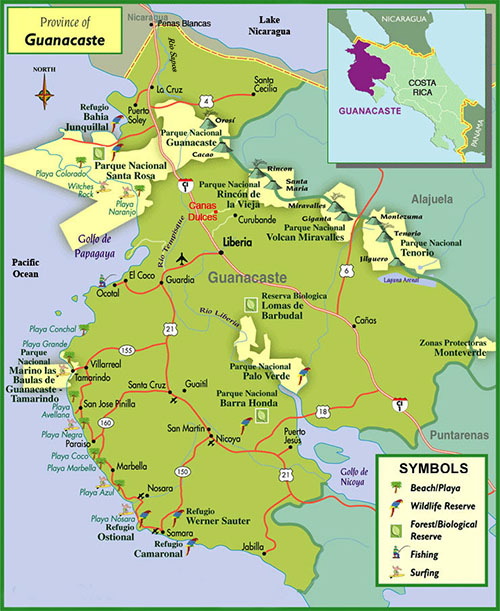
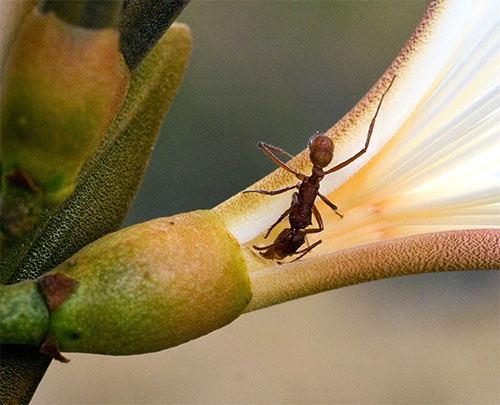
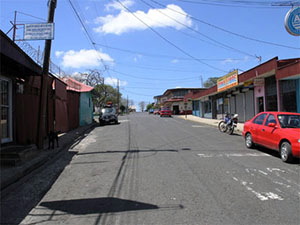 There we found a little hole-in-the-wall restaurant with five tables--and the best food we'd had the whole time we'd been in Costa Rica. Meals at Buena Vista Lodge were always good, but the fare at the La Cruz eatery was especially tasty and well-prepared. (The chocolate-covered donut from the bakery next door was awfully good, too.)
There we found a little hole-in-the-wall restaurant with five tables--and the best food we'd had the whole time we'd been in Costa Rica. Meals at Buena Vista Lodge were always good, but the fare at the La Cruz eatery was especially tasty and well-prepared. (The chocolate-covered donut from the bakery next door was awfully good, too.)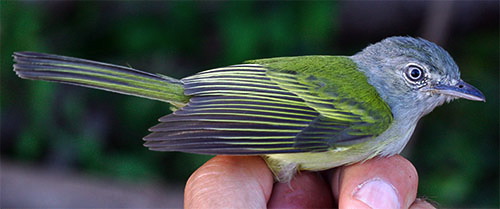
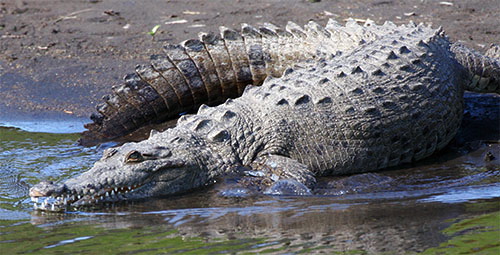
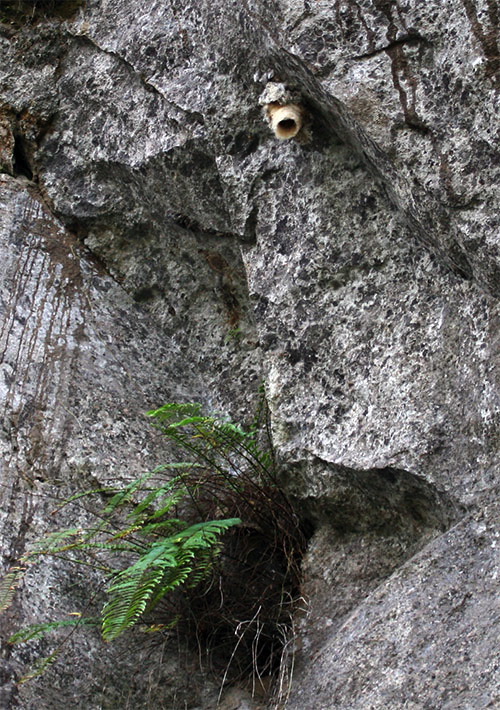
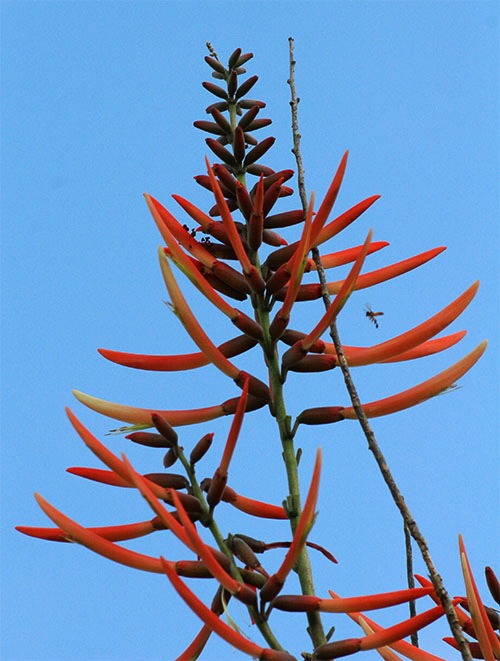

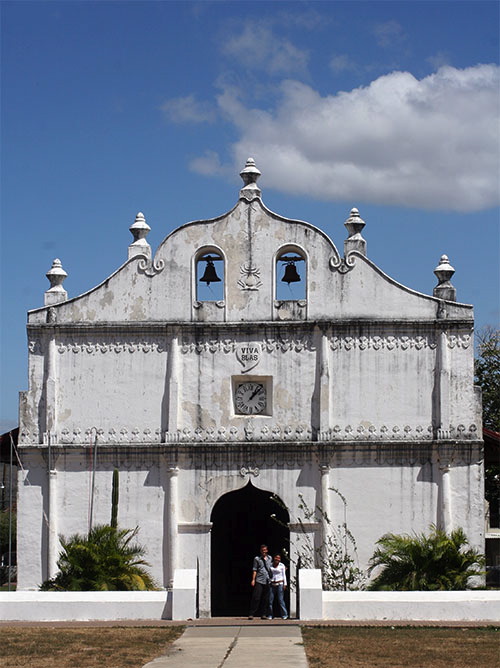
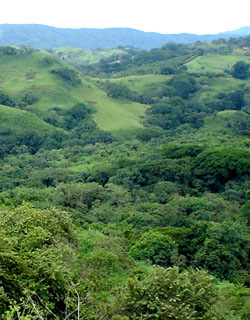 Upon taking early retirement, Cis decided to spend part of each year on land in Costa Rica; rather than pillaging her property she wanted to do what she could to restore it to a more natural state. In years since she has built a small cottage, weeded out non-native vegetation, and installed many sustainable and nectar-bearing plants. But the real reason we wanted to visit was because Cis told Ernesto's mother that Ruby-throated Hummingbirds were coming to sugar water feeders on her porch AND we were welcome to band them. Curious about what was going on at Cis's isolated farm, we finally arrived there late afternoon on 12 February. In about 15 minutes we saw seven species of hummingbirds--including several ruby-throats!
Upon taking early retirement, Cis decided to spend part of each year on land in Costa Rica; rather than pillaging her property she wanted to do what she could to restore it to a more natural state. In years since she has built a small cottage, weeded out non-native vegetation, and installed many sustainable and nectar-bearing plants. But the real reason we wanted to visit was because Cis told Ernesto's mother that Ruby-throated Hummingbirds were coming to sugar water feeders on her porch AND we were welcome to band them. Curious about what was going on at Cis's isolated farm, we finally arrived there late afternoon on 12 February. In about 15 minutes we saw seven species of hummingbirds--including several ruby-throats!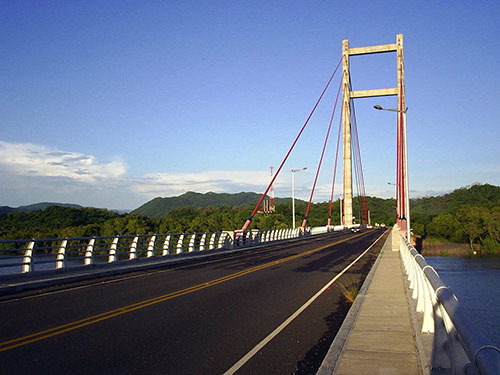
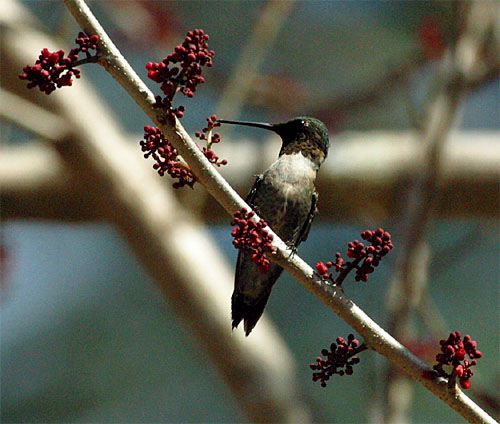
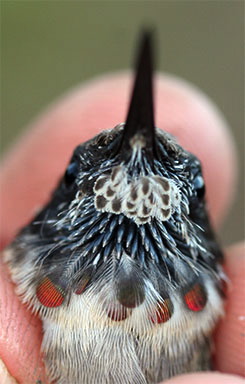 Young males after that date became SY or Second Year birds, while all females (which cannot be aged with complete certainty on the wintering grounds) became AHY or After Hatch Year. Most adult males with full red gorgets (above, feeding at a Jocote tree) are categorized as AHY, but careful examination of their primary wing feathers for length and molt after 1 January may reveal some are ASY or After Second Year birds that must have hatched out at least two summers before.
Young males after that date became SY or Second Year birds, while all females (which cannot be aged with complete certainty on the wintering grounds) became AHY or After Hatch Year. Most adult males with full red gorgets (above, feeding at a Jocote tree) are categorized as AHY, but careful examination of their primary wing feathers for length and molt after 1 January may reveal some are ASY or After Second Year birds that must have hatched out at least two summers before.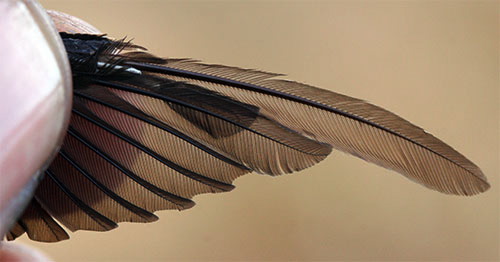
 The #9 primary is big and broad and may be the most important feather for long-distance flight; molting it last means it is fresh and new for the spring journey north. (In the photo above, a second year male has new primaries #1-7 with #8 in partial quill, bears an old #9 primary, and has lost its #10 primary that will be coming in next. Eventually #9 will drop out and be replaced, providing the hummer with a complete new set of all-important primary feathers in time for northward migration.)
The #9 primary is big and broad and may be the most important feather for long-distance flight; molting it last means it is fresh and new for the spring journey north. (In the photo above, a second year male has new primaries #1-7 with #8 in partial quill, bears an old #9 primary, and has lost its #10 primary that will be coming in next. Eventually #9 will drop out and be replaced, providing the hummer with a complete new set of all-important primary feathers in time for northward migration.)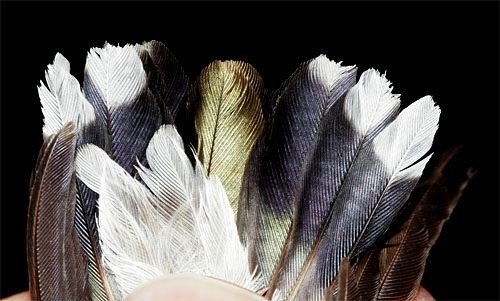 More important than the molt information, we have recaptured three RTHU in Costa Rica we banded there in previous winters; these birds--a female and two males--are the first to show that at least some ruby-throats demonstrate site fidelity on tropical wintering grounds--just as they do at breeding sites in the U.S. and Canada. Such knowledge emphasizes the importance of protecting habitat on BOTH ends of the species' migratory path.
More important than the molt information, we have recaptured three RTHU in Costa Rica we banded there in previous winters; these birds--a female and two males--are the first to show that at least some ruby-throats demonstrate site fidelity on tropical wintering grounds--just as they do at breeding sites in the U.S. and Canada. Such knowledge emphasizes the importance of protecting habitat on BOTH ends of the species' migratory path.


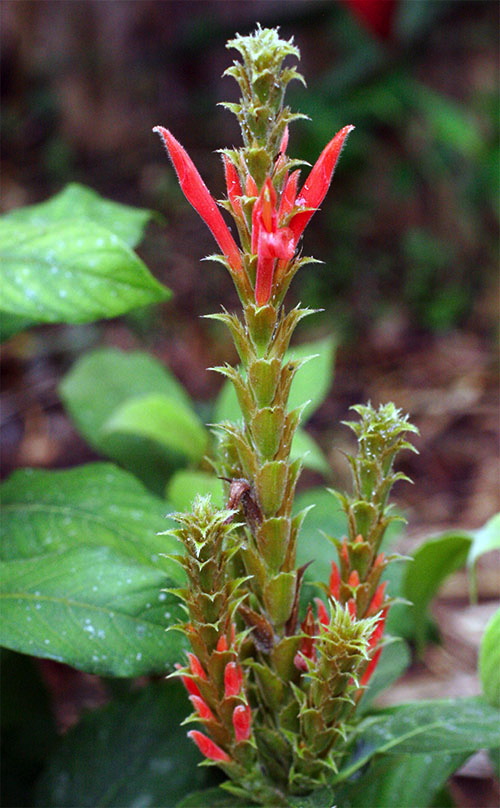
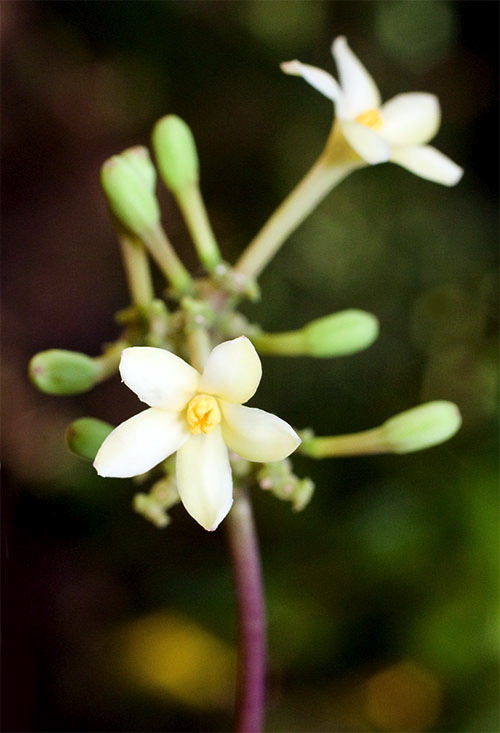
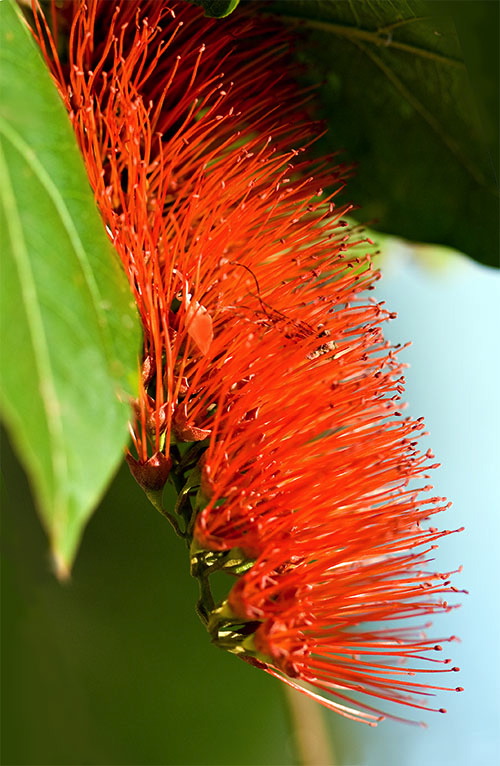
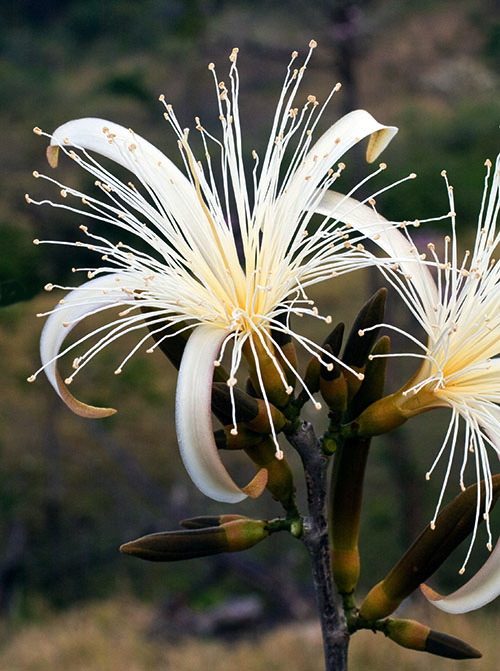
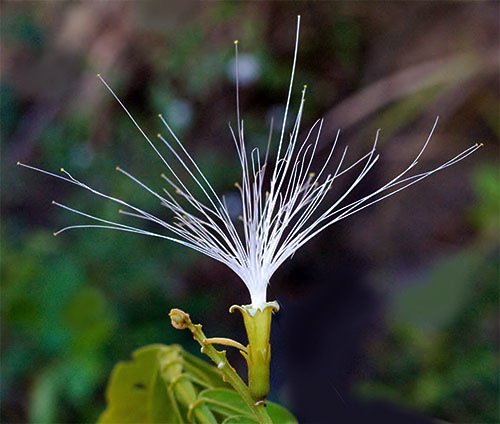
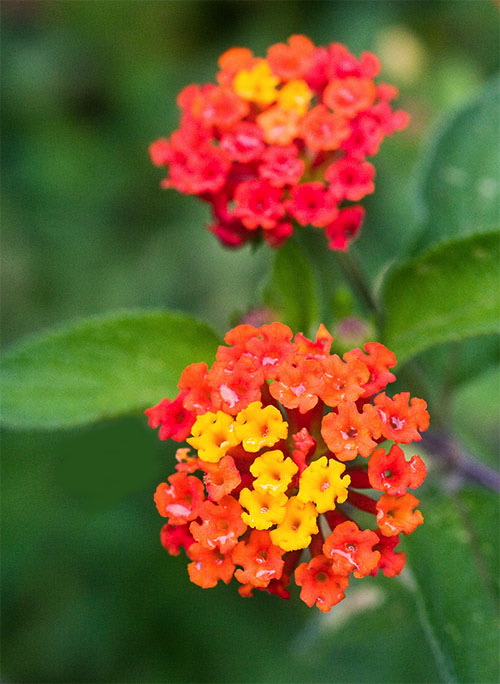
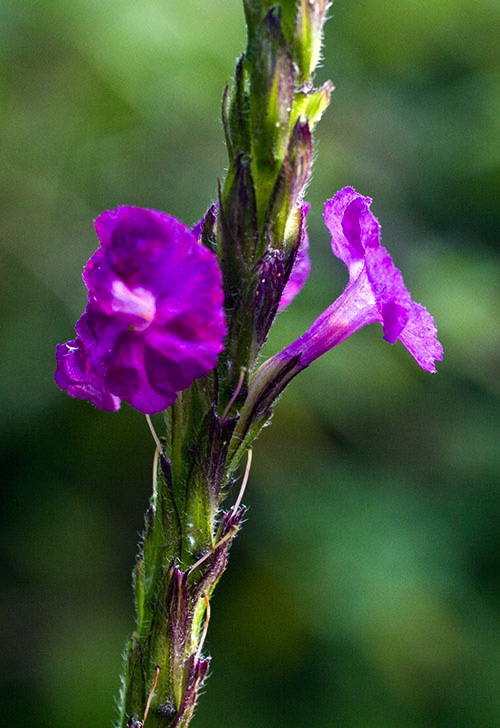

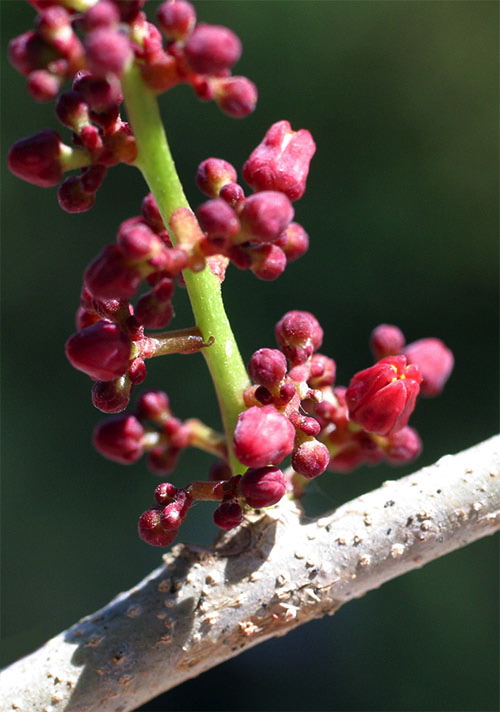
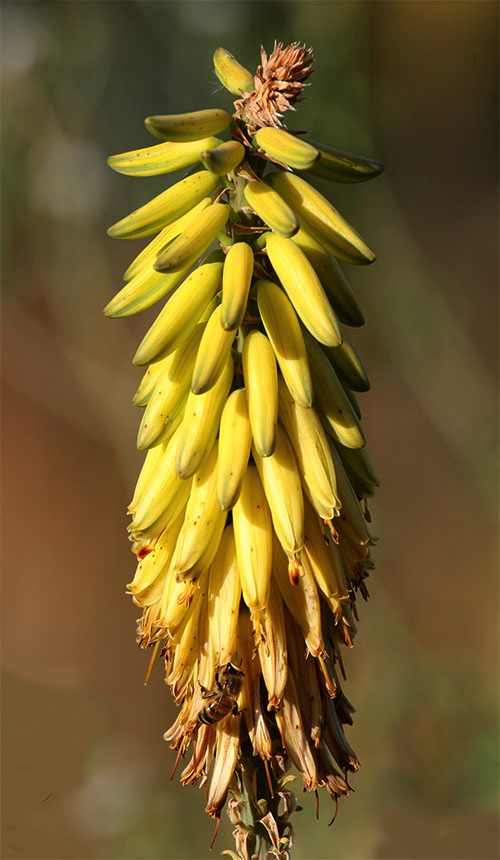




 Oct 15 to Mar 15:
Oct 15 to Mar 15: